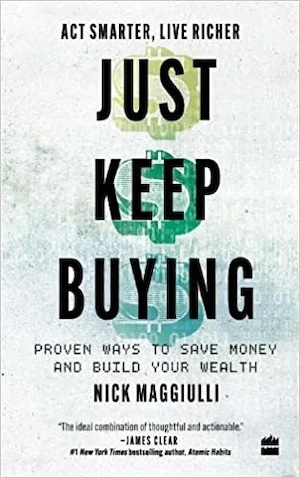Spoiler alert: Just Keep Buying (available now on Amazon) is an excellent personal finance and investing book. If it had been written 30 years ago, it would have been one of the best ever.
I know that sounds like I’m lauding author Nick Maggiulli while also damning him with faint praise.
But it’s simply a reflection of the spread of investing knowledge on the Internet since the 1990s. (At least until TikTok and YouTube started ruining things.) There’s far more competition.
Good accessible investing books were once rare jewels. I owned them all!
But today I suspect only a minority of even the keenest DIY investors buy and read a book about it.
Tens of thousands of decent investing articles are freely available online. Sorting the wheat from the chaff isn’t an efficient way to learn – and there’s always a risk you’ll accidentally become a meme stock day trader. But given time, the Internet can teach you all you need to know.
It has been a Cambrian explosion of engaging voices and investor empowerment.
Even so, reading a concise and actionable primer like Just Keep Buying could save you months of trawling and dead-ends.
That the book happens to be an engaging read is even better.
Crushing it
Nick’s blog Of Dollars and Data will already be familiar to readers of our Weekend Reading links.
In fact, much of the book will be.
That’s because – to stretch my Cambrian metaphor – Just Keep Buying is like the enduring fossil record of everything the wiser personal finance and investing voices have agreed upon over the past 20 years.
Save regularly and automatically. Invest passively with index funds. Diversify according to your age. You probably know the drill.
Indeed Nick himself contributed some of the best of that raw material.
I regularly find other bloggers quoting his seminal Even God Couldn’t Beat Dollar Cost Averaging for instance. (On a good day they even link to him…)
Just Keep Buying compresses it all down into an action plan. It reads like a very intelligent person consumed the passive investing bloggerati consensus, checked it against the data, and squeezed out the essentials on how to do it right.
Think of how tectonic forces crush coal to leave a diamond.
Nick’s book even sparkles in its way.
Easy reader
It’s ridiculously readable, for one thing.
It wouldn’t be right to say Just Keep Buying reads exactly like a blog, although it does repurpose some articles first posted on Nick’s website.
As I said, it’s much better structured than a blog.
But there’s that blog feel, in the short, attention-grabbing chapters.
Nick leans heavily too on the now familiar blog scaffolding made popular – at least in our sphere – by superstar money writer Morgan Housel.
Each chapter starts with the hook: a characterful and often only tangentially-related story from the world of science, geography, or astronomy. Then there’s the bridge to investing. Then the meat of what you need to know. All so cleanly dispatched you hardly notice the education going down.
For example a chapter on why you shouldn’t fear volatility starts with the founder of Federal Express gambling his company’s dwindling cash at Vegas, to stave off imminent bankruptcy.
The message? Risk comes with the territory. What’s important is taking an appropriate level for your needs and time horizon. But the image of a CEO playing blackjack to save his company is far more arresting than that previous bland sentence was.
Chapter after chapter slides by this way. Before you know it you’re halfway done.
For a book about a potentially dry subject, Just Keep Buying is a page turner.
Putting Just Keep Buying to work
That halfway point is where Just Keep Buying pivots. The first half is all about personal finance. The second half focuses on investing.
Like this the book first outlines how, why, and how much to save – with useful detours into debt and home buying – before explaining how to put your money to work to create long-term wealth.
There’s not much prevarication. Nick makes the case for each step like a confident barrister. Save this much to aim for that much. As you’d expect if you know his writing, he also backs up each strategy with data. So he doesn’t just tell not to sit around in cash waiting for the next crash. He’s got the data to prove why it’s usually a losing strategy.
There’s plenty of graphs too. These are very welcome, albeit they’re not quite as easy to read in printed form as on his website.
And there’s the judicious deployment of personal anecdotes.
As a Stanford graduate with a fairly modest background who is now moving and shaking in New York, Nick straddles several worlds. Yet he deploys his experiences lightly.
For example very late in the book he reveals his family’s financial fall from grace during the US housing downturn in the 2008 crisis. Where others would have opened the book with a strident claim to have risen from the ashes or whatnot, Nick just makes a level-headed point about the perception and reality of wealth. It’s disarming and effective.
Slightly less successful is a range of quotes and other sources sort of shoehorned into the copy. We even get US shock writer Tucker Max’s advice not to be an angel investor, for instance. Perhaps these are part of what makes the book such a breezy read, but at least for me they feel a bit like they’d been peppered in to spice up or add depth to the message.
I feel the book is at its best when Nick just tells us what he thinks.
Sincerely simplified
On that note, a flipside to Nick’s confident no-nonsense approach is you’ll probably find some things you disagree with. There’s usually a caveat in the text (just like my ‘usually’ there) but in some places Nick’s rules do stretch the sense of that word.
There’s no law that says you must save as much as you splash out to assuage spending guilt, for example (Nick’s 2x rule). And a throwaway comment that you could give your match to charity instead would in reality produce a vastly different financial outcome over a couple of decades.
Similarly, while I understand the mathematics that says somebody with a high savings rate ‘must’ save more of any future salary raise to stay on-target – because that target has been arbitrarily defined as retirement spending that’s a certain percentage of their pre-retirement spending, reached by a predetermined date – the reality is that if you save hard for a couple of decades you actually have huge optionality later.
Of course there will be consequences if you spend your raises in your 50s and 60s. But you won’t really be breaking any savings rules.
This isn’t to take anything away from Just Keep Buying. Nick shows his workings, as my old maths teacher used to say. He’s not preaching a huckster’s secret way to wealth. Many readers will find his clear instructions hugely helpful and reassuring. Those who want to tweak the formulas will do so from a solid starting point.
The same could be said for the investing chapters. We don’t get a deep dive into asset classes or platforms or anything else.
But how many people really need that?
Our chapter on bonds in the never-published Monevator book is longer than Nick’s entire summary of the pros and cons of the most important assets to build a portfolio. But honestly? For most people his summary will be enough. For them a simpler guide that is easily digested and put to work will trump a deep dive that satisfies the purists (even one that has been published!)
That said, one thing I’m not quite sure about is whether I found the book to be such an easy read because I’m so well-versed in this stuff.
Nick talks a lot about volatility, for example. That’s a bread-and-butter word for old hands, but opaque to the uninitiated. I think a moderately intelligent reader would have few problems. But I guess some people could find the simple messages obscured by unfamiliar lingo, despite Nick’s best efforts.
I should mention too that the book was written for a US audience. In practice there’s only one chapter where this matters – a provocative section on how to best use US tax shelters that actually is a bit contrary to that prevailing consensus I talked about.
You won’t get much from that if you’re not a US citizen. But the rest of the book is universal.
A sticker and a keeper
In the 15 years since starting this blog, I’ve seen many money bloggers come and go.
I still remember finding Nick’s blog, Of Dollars and Data. That first article featured his trademark animated data-visualizations, which might as well be black magic to us Cro-Magnons at Monevator.
Better still, Nick’s words lived up to the fancy graphics.
I gulped and copied the link for Weekend Reading.
Long ago I decided that if we were going to be outgunned by smarter, savvier new kids on the block then at least I’d do my small bit to bring them to the world’s attention. That’s one reason why I’ve kept linking to other websites each week for all these years – and long after it fell out of fashion. (The other is so you enjoy my finds and keep reading us to discover more!)
There’s been a lot of false alarms along the way. Many people have a couple of great blog posts in them. Some a half-a-dozen.
But very few keep up the quality for years.
Nick has – even several years in and after his blog turbo-charged his career (and I presume his workload). And now he has a great book to add to his resume.
Just buy it
Just Keep Buying is among the best of the spate of investing blogs turned into books. It’s not quite at the level of Morgan Housel’s The Psychology of Money, but that was one for the ages.
Besides – whisper it – much as I adore Housel’s writing and will laud The Psychology of Money as much as the next jealous blogger who’s unlucky enough to be writing at the same time as him, Nick’s book will probably deliver more takeaway value to more people.
That’s because Just Keep Buying is both a solid mantra and a call to action.
Yes, if you’ve been knocking around these parts since the financial crisis it’ll be reassuringly familiar, like a greatest hits album. But if you’re newer, it could seriously accelerate your progress.
It would also be a perfect gift for that smart, curious, would-be investor in your life.
If you’re looking for a comprehensive manual on the nuts and bolts of even simple passive investing, you’ll have to buy a companion tome. (Or keep reading Monevator!)
But how many people really need that? For 90% of its target market, Just Keep Buying will get 95% of the job done. Recommended.
You can get your copy of Just Keep Buying via our Amazon affiliate link. (Here’s the US link). Nick did kindly send me a copy of his book for review. He also wrote a personal note at the front. But I don’t believe these thoughtful gestures have bamboozled me into liking his book!




